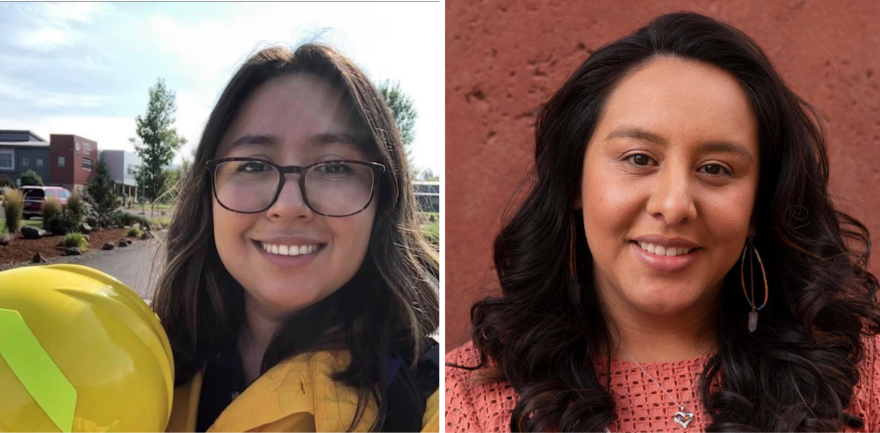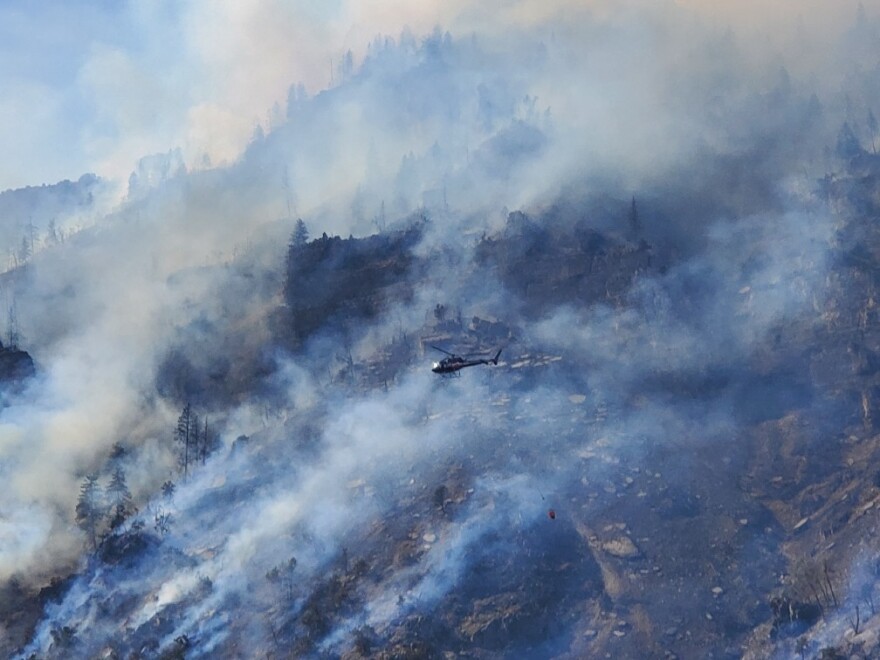Pueden encontrar la versión en español aquí.
In the summer of 2020, residents and visitors of Garfield County saw one of the worst wildfires in Colorado history.
More than 32,000 acres burned, and the fire got dangerously close to communities in and around Glenwood Canyon, forcing evacuations.
Critical infrastructure was threatened and the fire caused an extended closure on Interstate 70.
The majority of the information dispersed by Garfield County to the community during the fire was in English. Monolingual Spanish speakers and people who prefer Spanish had reliable translations from some sources, but that varied widely.

The fire began on Aug. 10 and the Garfield County Emergency Communications Authority notified local firefighters and other first responders who deployed to the scene.
Similar to Pitkin County’s Pitkin Alert system, Garfield County’s dispatch center also sends alerts through an emergency-notification system.
That information goes directly to a person’s cell phone or email after they sign up online.
But these alerts are only dispersed in English.

Request for bilingual dispatchers
Crystal Mariscal is a member of the Garfield County Latino Community Committee, which informs Garfield County commissioners on important topics and issues to the Latino community.
The committee recently made requests to the dispatch center to hire more bilingual responders because many Spanish speakers aren’t comfortable calling 911.
“They're going to wait until the last resource to call 911,” Mariscal said. “That's not something they're going to feel comfortable doing.”
Tom Holman, operations manager for Garfield County’s dispatch center, says they have been working on hiring more bilingual people, but at this time, they have only two.
In the meantime, they are training 10 dispatchers to learn Spanish with the online language-learning platform Babbel.
Holman adds they don’t want to rely on a service such as Google Translate for their alert system because they don’t want to share any flawed translations.
Mariscal remembers a time six years ago when the Garfield School District No. RE-2 sent out a phone message with an inaccurate translation to parents at Elk Creek Elementary School in Newcastle that caused concern.
“I received a message in English first about a bear outside of the school,” Mariscal said. “Seconds later, like probably a minute later, after that, I received another one in Spanish saying there's a bear inside of the school. It is a totally different message and they use Google Translate.”
Lisa Pierce was the principal of Elk Creek Elementary School in 2016.
She remembers the incident with the bear, but she recalls the message delivered in Spanish also said the bear was outside of the school.
Pierce added that the school used Google Translate for its alert system but bilingual staff members edit those translations.
Holman with the dispatch center says he’s concerned about the possible implications of using Google Translate for their alerts.
But according to data from the U.S. Census Bureau, 30% of people reported identifying as Latino in Garfield County, and 25.8% of people speak a language other than English at home.
And according to 2020 census data compiled by Aspen Journalism, 53.6% of students in Garfield’s RE-2 school district identify as Hispanic or Latino.
So, for now, Spanish-speaking families in Garfield County remain without translations from dispatch.

Translation efforts at sheriff’s office
Garfield County Sheriff Lou Vallario says his department is using platforms other than dispatch alerts to spread information during an emergency.
“We're doing Facebook, we're doing Twitter, we're calling the local radio stations or sending out press releases,” Vallario said.
“Everything we can do to get the word out, and again, even going door to door when we're in the process of an evacuation.”
Within the first few days of the Grizzly Creek fire, Facebook became one of the department’s main methods of information dissemination.
A review of the archived posts on the Garfield County Sheriff’s Facebook page showed that all of its original posts about the Grizzly Creek fire in August of 2020 were in English.
A national Type 1 incident management team arrived on scene within the first few days of the fire and took over communications on the “Grizzly Creek Fire” Facebook page, set up originally by the Forest Service.
The federal team hired Elizabeth Velasco of Glenwood Springs to translate and interpret its content. She’s a former wildland firefighter and a certified Spanish translator.
(Velasco is running for the state legislature in House District 57, and Aspen Public Radio has a contract with Velasco’s company for translation services.)
But some community members said they wanted local agencies to step up and do the same work.

Jasmin Ramirez worked for Voces Unidas, a Latino-led advocacy nonprofit, during the Grizzly Creek fire.
She is now a school board member of the Roaring Fork School District.
And she helped lead an effort online and on Facebook requesting that the Garfield County Sheriff’s Office interpret and translate its meetings and updates about the fire.
"We put a call out to action from the community and started asking people to start emailing, saying, ‘We have a lot of Latino families, and we really need you to start messaging in Spanish because this is life or death for some of our families,’” Ramirez said.

Ramirez and others shared a form letter on Facebook so people could easily reach out to the department with this request.
It said the Spanish-speaking community was “worried and scared” about the fire.
The sheriff’s office was in charge of the evacuations in No Name and other communities south of the fire.
They also issued pre-evacuation notices for other residential areas, including Sweetwater, which is north of Dotsero.
But the Facebook posts from the sheriff’s office regarding evacuations were not offered in Spanish.
However, press releases about evacuations two days after the fire began, were translated by the federal incident management team working on the fire and uploaded to the “Grizzly Creek Fire” Facebook page and Garfield County’s emergency management feed. That’s according to Renelle Lott, chief communications officer for Garfield County.
But despite those other translations, Ramirez said multilingual communication should be a bigger priority at the sheriff’s office.
“If any of our community needs any translation services to be able to survive and thrive here in the city, let alone in the state, we should be providing those services,” Ramirez said. “Other cities are expected to do it. Other counties are expected to do it. We are a diverse population.”
Walter Stowe, a communications officer for the Garfield County Sheriff’s Office, responded to the translation requests in 2020, saying the emails from Ramirez and other community members were better addressed by the federal incident team, which had more resources.
He adds that by the time he began receiving these messages, the sheriff’s office was no longer involved in managing the fire.
“Once it's turned over to a Type 1 team, we're responding to other things at the sheriff’s office,” Stowe said. “So, it frees up your resources to do the job we would normally do. So, the fact that we would be posting things or reposting things, we would just be doing that as a service to the Type 1 team.”
But the sheriff’s office was still sharing information on Facebook about evacuations, pre-evacuations, road closures, and shelters regarding the Grizzly Creek fire weeks after the Type 1 team took over.
Vallario said the requests were a wake-up call, and the sheriff’s office has made some changes to their services since then.
“So, during the Grizzly Creek fire, we kind of got chastised a little bit that we weren't providing translated information to the Latino community,” Vallario said. “And quite frankly, they were right. And so we now take the time to translate those things and particularly in emergencies so we can get that out to all the communities.”
He says information will be sent in Spanish when bigger emergencies arise.
A review of the “Garfield County Sheriff’s Office” Facebook page shows all posts between June and August were disseminated in English except for some flyers and videos promoting domestic-violence awareness classes.
It was a quiet summer when it came to large, destructive wildfires, but Facebook posts from the sheriff’s office updating people on smaller fires were not translated into Spanish.
Vallario says bigger counties with bigger budgets can dedicate funding so that a handful of people are working on social media communication, but it’s not within the sheriff’s budget to provide more translations at this time.
“And the other thing is, we have to look at priorities,” Vallario said. “Do I need another deputy on the street to respond to criminal behavior out there, or do I need a second person to manage our Facebook and translation? So that's priorities and balances I have to make as the sheriff and the department head when I put my budget in. Right now, I'm comfortable with what we're doing.”
Vallario says he employs a number of bilingual deputies who do interviews and public service announcements in Spanish on the radio station La Nueva Mix, but they provide more-general safety information.

Role of fire departments
Vallario says that for smaller wildfires, a Spanish speaker can go to their local fire department for more fire-specific information.
But someone might not know which fire department or district is responding, as they often have different levels of Spanish translations.
For example, the Carbondale & Rural Fire Protection District translates a lot of its Facebook posts.
Jenny Cutright is a public information officer for Carbondale’s fire department.
“This is life safety information,” Cutright said. “A lot of the things we put out really can save your life. I want to make sure that people get the information that they need when they need it in their language.”
Cutright says the department has dedicated $10,000 of its roughly $4 million budget to Spanish translations.
On the other hand, Colorado River Fire Rescue based in Rifle does not translate its posts, saying it doesn’t have the resources for that kind of communication.
Both respond to fires in Garfield County, but they have fewer followers on Facebook than the sheriff’s office.
The two fire departments have 8,000-9,000 followers and the sheriff’s office has about 18,000.

Community steps in
Some Spanish speakers have been developing their own social media pages to fill the gaps in Spanish translations around the Roaring Fork Valley.
Illiana Renteria helps to run the Facebook page “Emergencias y Recursos Aspen a Parachute,” which translates to “Emergencies and Resources Aspen to Parachute.”
Renteria, who is not a certified translator, is bilingual and runs the social media pages for a number of nonprofits in the Roaring Fork Valley.
She translates emergency alerts from various agencies in the Roaring Fork Valley since she finds many Spanish translations to be insufficient.
“When alerts or something official came translated, it was my perception that it was translated automatically,” Renteria said. “So, sometimes it's even harder for me to understand.”
Renteria is volunteering her time to do this work, so the page’s response time is often dependent on her otherwise busy schedule.
Ramirez acknowledges that Garfield County is making strides in translating some material, but she says getting Spanish information from the sheriff’s office is critical.
“It's not enough that they just do their public health in Spanish or the human services in Spanish because the sheriff's office is the direct communication with our residents,” Ramirez said. “And if they can’t have the sheriff of the county doing right by all of their citizens and residents, then it's performative equity.”
This is the second story of a three-part series on Spanish-language emergency alerts in the three counties that make up the Roaring Fork Valley: Pitkin, Eagle and Garfield counties. The next story looks at the progress Eagle County has made to translate its emergency alerts since the 2018 Lake Christine Fire.




